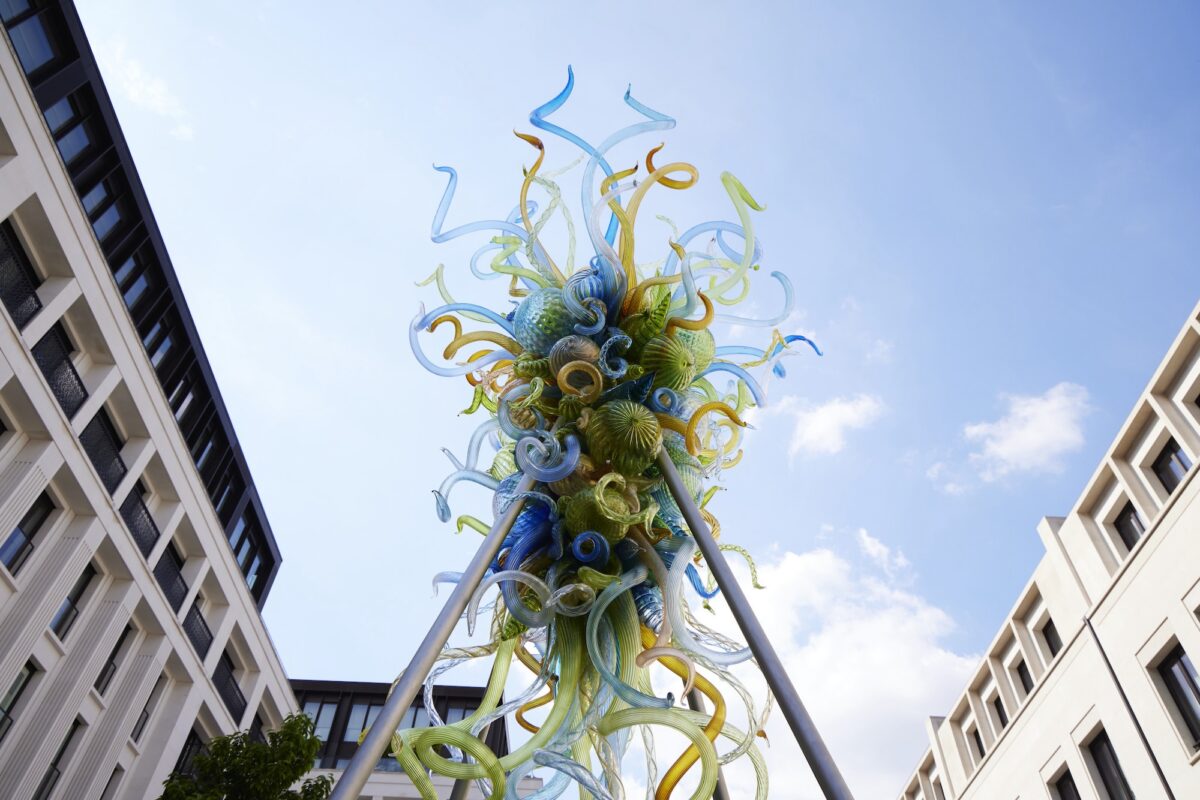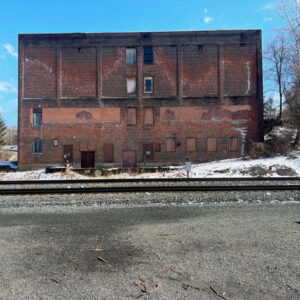It’s a rainy morning and I am standing in front of Electric Yellow and Coral Tower, a nearly 4.5 meter-tall sculpture by renowned Seattle glass master Dale Chihuly, made up of hundreds of individually blown glass pieces, intricately shaped to mimic organic tendrils in vibrant yellows and coral hues, reminiscent of writhing tongues of fire. The sculpture acts both as a centrepiece and yet complements the beautifully planted landscaped gardens of Chelsea Barracks’ Mulberry Square, with pop of purple alliums and orange flowers in the lush greenery.

The monumental piece is here as part of Chihuly at Chelsea Barracks, a series of four sculptural installations marking the inaugural edition of Modern Masters, a free outdoor programme of contemporary art curated by public art and cultural placemaking agency New Public, in partnership with London Craft Week (LCW)
Last September, in anticipation of LCW’s 10th anniversary this year, the organisation approached New Public with a brief to highlight craftsmanship outside of the traditional perception of crafts, expanding its reach within an architectural and urban context.
Together, New Public and LCW developed a theme pinned on the idea of Modern Masters, offering a platform to celebrate the work of leading contemporary artists, highlighting the skills and craftsmanship supporting sculptural works in the public realm, such as welding, casting, glassblowing, and woodwork, as well as the incredible materiality and remarkable collective effort behind these masterpieces, while reaching new audiences.
This first iteration of Modern Masters – Chihuly at Chelsea Barracks – is the vibrant display unveiled during LCW, but the ambition in the years to come is to expand its presence city-wide throughout future editions of LCW, with a long-term goal ‘to work throughout the city across different estates and public spaces’, reveals Rachael McNabb of New Public.
The most important aspect that really resonated with all partners – New Public, LCW, Chelsea Barracks and Chihuly Studio – is the freely accessible nature of Mulberry Square. The installations are completely site-specific, and on display until October, well beyond LCW.

It was important to ensure that the work was on display for a longer period, as we all agreed that the collective effort required to place these piece in dialogue with their context called for a more durable installation
says New Public’s Lorna-Rose Simpson.
My visit is led by Keri Schroeder from Chihuly Studio, and she tells me that
‘the studio works with the awareness that there is an element of adaptation in understanding each site and, while there is a huge amount of collaborative conversation in the process of choosing and siting the right works for the space, we knew that, until we were on site, we wouldn’t be able to fully determine the exact location, and appreciate the symbiotic relationship of each pieces with its surroundings’.
The four large-scale sculptures on display – encompassing different series from Chihuly’s much loved and popular works – Chandeliers, Towers, Reeds and Fiori – are in dialogue with each other and with the context of Chelsea Barracks’ public space and architecture.

So how does Chihuly choose the right piece for each project?
‘The starting point is to look at existing pieces, and also new ideas that Dale (Chihuly) wants to create,’ –
‘A lot of it comes down to colour – a key component in Chihuly’s work. But the process really has the public at the forefront, as we very much focus on how would anyone – a child, or a regular passer-by – react to the work? So we are very mindful that the work is sited within its architectural boundaries, building a dialogue’.
Keri Schroeder
The relationship with the contextual environment is plain to see, with the added consideration that the natural environment plays an ever-revolving role, as it changes all the time and in every season.
There is an educational process required in siting the pieces, as we need to be able to work with the natural context and not disrupt it. Colour is at the core of Chihuly’s work, and he is very keen to complement and enhance the colours of the landscape at all times
continues Schroeder
In tandem with this is the idea of creating an artistic experience accessible to everyone, as Chihuly is adamant that his work isn’t recognised by art historians and critics only, but generates a sense of wonderment in viewers from all walks of life.
Chihuly’s glass-blowing technique stems from traditional Venetian glassblowers (he was an apprentice at the Venini Vetreria furnace), but in the 1970s he started to experiment with a more fluid and organic approach, using gravity and allowing the glass freedom to follow a more natural shape, breaking away from the very formal and rigid teaching of the Venetian heritage. He did however maintain the collective spirit of the glassblowing workshop, and still today Chihuly Studio produces every single individual component as a team that can have up to 20 glassblowers and welders working at one time.
Once assembled and completed in the studio, each composition is then dismantled and individually wrapped and shipped to its installation location to be reinstated, with the final phase happening directly on site. Glass is an incredibly resilient material, that can last for hundreds of years in complete stability. It is also, of course, a relatively fragile material, which contributes to the sense of wonder in encountering these complex pieces outdoors.
Within the Modern Masters display, a completely new piece, Amethyst Reeds, uses multiple colourways including deep purples and vivid magentas, in an interplay of opacity and transparency of each individual reed – up to three-metre long spikes in tubular forms which emerge from logs of raw wood. The piece sits on a water feature, which posed a significant challenge to the production team, resulting in a creative solution found in the constraint of the space. Positioned by the entrance, towards Pimlico Road, visitors are welcomed by this powerful piece, which masterfully balances the tension between the straight glass reeds and the organic form of the wooden base.
There are also new groupings of floats, solid irregular spheres of richly colourful glass, which allow a deeper appreciation of colour and explore the material’s unique relationship with light. The whimsical nature of the pieces is open to interpretation, leaving the public to let their own imagination run wild.
We’re just as fascinated with colour as the viewer is, As we also don’t fully know how the pieces are going to come out, it is a constant exploration’.
says Schroeder

Mulberry Square Fiori – a site-specific composition of soaring blue tentacle-like curling shapes sinuously emerging from the ground, and Aqua Blue and Amber Chandelier, featuring a cascade of amber, gold and citron shapes of glass combining long, trailing tendrils and bulbous marine globes suspended from a ‘quad pod’, complete the Modern Masters installation.
Until the end of May, an accompanying display of Chihuly’s gallery pieces – featuring vessels, baskets and floral displays in more conventional scale, can be seen in the adjacent Garrison Chapel, home to the King’s Foundation, which showcases the work of the charity and its students and graduates.
While these uniquely attractive glass sculptures are designed to play with light, today’s grey London sky doesn’t take anything away from their remarkable presence, their organic, whimsical shapes drawing the eye in, generating a sense of curiosity and playful wonderment in the viewer. Do stop by if you’re in the area, they’re very much worth a visit.
Words MB
Modern Masters: ‘Chihuly at Chelsea Barracks’ is curated by New Public in partnership with London Craft Week. Until October 2024.



